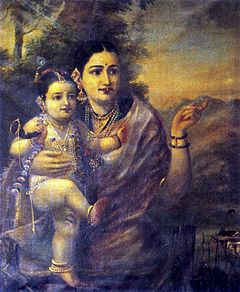
Back জন্মাষ্টমী Assamese जन्माष्टमी AWA जन्माष्टिमी Bihari কৃষ্ণ জন্মাষ্টমী Bengali/Bangla Krishna Janmashtami Catalan Janmashtami German Janmashtami Spanish Janmashtami French જન્માષ્ટમી Gujarati जन्माष्टमी Hindi
| Krishna Janmashtami | |
|---|---|
 | |
| Also called |
|
| Observed by | Hindus |
| Type | Religious (1–2 days), cultural |
| Celebrations | Dahi Handi (next day in the north), kite-flying, drawing footprints of infant Krishna, fasting, traditional sweet dishes, etc. |
| Observances | Dance-drama, puja, night vigil, fasting |
| Date | Shraavana Krishna Ashtami, Bhadra Krishna Ashtami |
| 2023 date | 6–7 September[1] |
| 2024 date | 26–27 August[2] |
Hindu festival dates The Hindu calendar is lunisolar but most festival dates are specified using the lunar portion of the calendar. A lunar day is uniquely identified by three calendar elements: māsa (lunar month), pakṣa (lunar fortnight) and tithi (lunar day). Furthermore, when specifying the masa, one of two traditions are applicable, viz. amānta / pūrṇimānta. If a festival falls in the waning phase of the moon, these two traditions identify the same lunar day as falling in two different (but successive) masa. A lunar year is shorter than a solar year by about eleven days. As a result, most Hindu festivals occur on different days in successive years on the Gregorian calendar. | |
| Part of a series on |
| Hinduism |
|---|
 |
| Part of a series on |
| Vaishnavism |
|---|
 |
Krishna Janmashtami (Sanskrit: कृष्णजन्माष्टमी, romanized: Kṛṣṇajanmāṣṭamī), also known simply as Krishnashtami, Janmashtami, or Gokulashtami, is an annual Hindu festival that celebrates the birth of Krishna, the eighth avatar of Vishnu. In certain Hindu texts, such as the Gita Govinda, Krishna has been identified as supreme God and the source of all avatars.[5] Krishna's birth is celebrated and observed on the eighth day (Ashtami) of the dark fortnight (Krishna Paksha) in Shravana Masa (according to the amanta tradition) or Bhadrapada Masa (according to the purnimanta tradition). This overlaps with August or September of the Gregorian calendar.[5]
It is an important festival, particularly in the Vaishnavism tradition of Hinduism.[6] The celebratory customs associated with Janmashtami include a celebration festival, reading and recitation of religious texts, dance and enactments of the life of Krishna according to the Bhagavata Purana, devotional singing till midnight (the time of Krishna's birth), and fasting (upavasa), amongst other things.[7] It is widely celebrated across India and abroad.[5][8][9]
- ^ "National Portal of India". www.india.gov.in. Retrieved 3 August 2020.
- ^ "National Portal of India". www.india.gov.in. Retrieved 3 August 2020.
- ^ "National Portal of India". www.india.gov.in. Retrieved 3 August 2020.
- ^ "National Portal of India". www.india.gov.in. Retrieved 3 August 2020.
- ^ a b c James G. Lochtefeld (2002). The Illustrated Encyclopedia of Hinduism: A–M (PDF). The Rosen Publishing Group. ISBN 978-0823931798.
- ^ J. Gordon Melton (2011). Religious Celebrations: An Encyclopedia of Holidays, Festivals, Solemn Observances, and Spiritual Commemorations. ABC-CLIO. p. 396. ISBN 978-1-59884-205-0.
- ^ Edwin Francis Bryant (2007). Sri Krishna: A Sourcebook. Oxford University Press. pp. 223–225. ISBN 978-0-19-803400-1.
- ^ Cite error: The named reference
:2was invoked but never defined (see the help page). - ^ "In Pictures: People Celebrating Janmashtami in India". International Business Times. 10 August 2012. Retrieved 10 August 2012.
© MMXXIII Rich X Search. We shall prevail. All rights reserved. Rich X Search